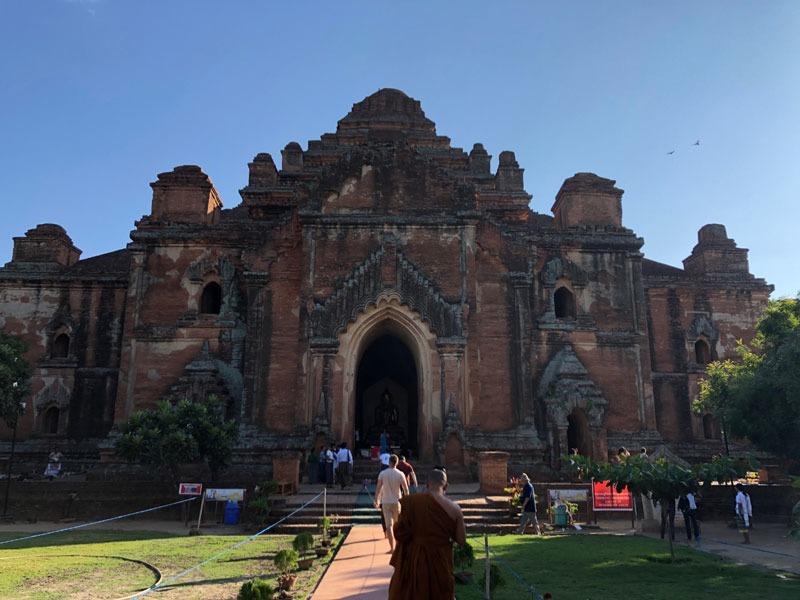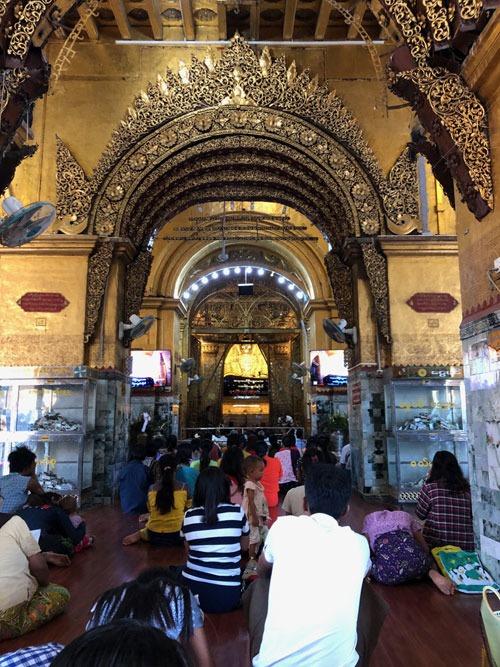Southeast Asian nation eases visa rules, other norms and builds facilities to promote tourism destinations
 Locals and tourists alike visit Dhammayangyi Pagoda in Bagan. Tourism is an important source of tax revenue for Myanmar. (PROVIDED TO CHINA DAILY)
Locals and tourists alike visit Dhammayangyi Pagoda in Bagan. Tourism is an important source of tax revenue for Myanmar. (PROVIDED TO CHINA DAILY)
Myanmar is courting Chinese tourists – and its efforts seem to be paying off.
Between January and October last year, Chinese tourists recorded the largest relative increase of 161 percent year-on-year among the different nationalities that visited the country, and also made up the biggest slice of the visitor pie during the period at 593,658, according to Myanmar’s Ministry of Hotels and Tourism (MOHT). Total visitor arrivals in the period increased 24 percent year-on-year to 35.2 million.
Between January and October last year, Chinese tourists recorded the largest relative increase of 161 percent year-on-year among the different nationalities that visited the country
However, the government is not resting on its laurels, and has laid down plans to attract more visitors from its northeastern neighbor to the country.
For instance, Myanmar has implemented a visa-on-arrival policy for Chinese nationals, effective from Oct 1, 2018 for a two-year period.
It is also in the process of implementing its existing Tourism Master Plan, while planning the next one spanning the time frame of 2020 to 2030.
“We are being supported by the Luxembourg Agency for Development Cooperation to do this,” said Maung Maung Kyaw, director-general of the directorate of hotels and tourism at MOHT.
“Broadly speaking, we are looking at creating new tourism destinations as well as building on labor and infrastructure capabilities to support the industry.”
READ MORE: President Xi says mutual learning will be of benefit
 Golden Palace Monastery in Mandalay. Tourism is an important source of tax revenue for Myanmar. (PROVIDED TO CHINA DAILY)
Golden Palace Monastery in Mandalay. Tourism is an important source of tax revenue for Myanmar. (PROVIDED TO CHINA DAILY)
Since 2017, MOHT has also been encouraging tour guides to learn Mandarin, training as many as 120 a month through the Myanmar Tourism Development Centre.
In fact, the Southeast Asian country’s commitment to this potential tourism segment is so strong that private kindergartens are teaching Mandarin as a language – a previously unprecedented move.
Other efforts are also being made to entice more Chinese tourists to Myanmar.
The Myanmar Tourism Federation (MTF) is a private sector organization established in 2011 and supported by MOHT. It has a membership of 11 tourism-related associations, including the Myanmar Tourism Marketing Association and Myanmar Hotelier Association.
Earlier this year, MTF launched the Myanmar Tourism Bank, with five percent of its profits feeding back into the tourism industry. In 2017, it set up an external committee focused on promoting Myanmar to China.
The initiatives by MTF include starting a WeChat account, making videos of the country’s attractions, and publishing books and guides to be made available in China.
Stretching approximately 2,000 kilometers lengthwise, Myanmar has everything from snow-capped peaks in the north to virgin tropical islands in the south
“We also attend travel shows in Guangzhou, Shanghai and Kunming to promote Myanmar to the Chinese,” explained U Yan Win, chairman of MTF.
“In December, we invited the chairman of Chinese online travel agency Ctrip to come over to experience our country.”
Maung Maung Kyaw at MOHT noted that the Chinese tourism dollar has helped to fuel the domestic economy, especially when they spend on food, sightseeing, shopping and zone fees.
“It is not only the central government that benefits; the regional governments do too,” he said.
“I hope that tourism becomes an important source of tax revenue for Myanmar.”
There is no reason why his wish will not come to fruition; after all, the country has countless attractions that appeal not just to the Chinese tourist, but to everyone else as well.
ALSO READ: ‘Magical run’ in a world heritage site
Stretching approximately 2,000 kilometers lengthwise, Myanmar has everything from snow-capped peaks in the north to virgin tropical islands in the south.
“At the moment, most tourists come and stay in Myanmar for an average of three days, visiting primarily Mandalay, Bagan, and sometimes Inle Lake,” said U Yan Win of MTF.
“But we have so many more attractions to offer outside of these places.”
 People visit Mahamuni Buddha Temple in Mandalay. Tourism is an important source of tax revenue for Myanmar. (PROVIDED TO CHINA DAILY)
People visit Mahamuni Buddha Temple in Mandalay. Tourism is an important source of tax revenue for Myanmar. (PROVIDED TO CHINA DAILY)
A key priority for MTF is to promote the country as an eco-tourism destination.
He points to the lesser developed northern regions of the country, such as the Hukaung Valley Wildlife Sanctuary in Kachin State, known as a tiger reserve area.
In the same state is the Khakaborazhi National Park – with a mountain of the same name that is an extension of the Himalayas as also the highest in the country at 5,881 meters and also provides trekking trails with views of snow-capped mountains.
MTF has aspirations to develop the southern regions of the country too, particularly the Tanintharyi Region.
“There are virgin islands, pristine diving sites, unparalleled marine biodiversity and fresh seafood. However, at the moment, only budget travelers visit as there is not much tourism infrastructure,” said U Yan Win.
“We are looking for opportunities to develop the area, such as to build five-star hotels,” he said, referring to places like the Mergui Archipelago and Myeik city.
Already, things are looking up. In the southernmost town of Kawthaung that borders Thailand there are plans to open an international airport, which would improve air connectivity to the region.
Memories Group, one of the most established high-end tourism companies in Myanmar, backs this plan. Its CEO Cyrus Pun has set his sights on the Mergui Archipelago.
“It has 800 islands that are unspoiled and untouched. In terms of marine biodiversity, fans of diving have told me that while the fishes there are smaller, there is a greater variety,” he said.
“At the moment, it is still exotic and inaccessible but this will all change in the next five to 10 years.”
Under his leadership, Memories Group is positioning itself to refocus on the Asian market, but targeting high-net-worth travelers, especially from Thailand and China.
He hopes to curate unique experiences to attract these tourists, such as a dinner cruise on Inle Lake, or a meditation class with a spiritual leader in Bagan.
We are investing in tourism but also protecting our country. It is aligned with respecting our culture
Maung Maung Kyaw, director-general of the directorate of hotels and tourism, Myanmar’s Ministry of Hotels and Tourism
“Myanmar still has a mysterious, exotic appeal. It has an innocence about it, tangible through its culture, history and the spirituality of the people,” explained Pun.
“We want to tell those stories and bring emotions into the experiences.”
Yet, along with the case for development in the tourism industry, it is comforting that the country’s leaders are aware that they have to do so in a responsible and sustainable way.
The Myanmar Tourism Law was passed in 2018 and it includes guidelines on how visitors should behave when they are in the country.
MTF’s U Yan Win said they are in consultation with the Tourism Authority of Thailand about best practices on managing the budget tourists through regulation.
The regional governments are cognizant of its importance too, with towns like Bagan working towards banning single-use plastics.
“We are investing in tourism but also protecting our country,” said MOHT’s Maung Maung Kyaw. “It is aligned with respecting our culture.”
While one of his biggest challenges is the negative publicity that Myanmar receives regarding its handling of socio-political conflicts between different communities, he hopes that travelers do not judge the country by what they read in the international media.
“Most of the conflict is isolated along the northern border, but ours is a big country. Come and see for yourself what Myanmar has to offer – you will help everyone in the country and contribute to the development of the economy.”


